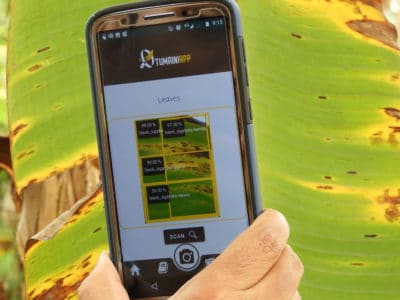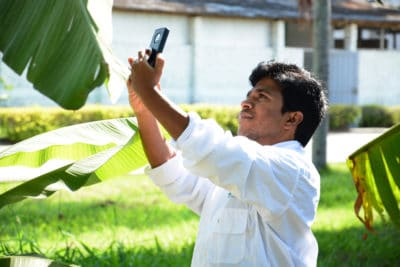AI with Appeal: Banana Farmers Spot Crop Disease, Pests with Deep Learning
Bananas are the world’s favorite fruit. If you don’t count tomatoes as fruit. (And really, who does?)
But banana crops around the globe are afflicted by diseases and pests that threaten the livelihoods of small-scale farmers, most of whom rely on just one or two cash crops and lack the resources commercial farms use to monitor the health of their plants.
A new AI app aims to help resource-poor farmers more accurately identify and treat banana diseases, improving their crop yields. Called Tumaini, meaning “hope” in Swahili, the app could also give nonprofits and governments more information and tools to control disease outbreaks in bananas and other crops.
Trained using NVIDIA GPU technology, the convolutional neural networks behind Tumaini achieve around 90 percent accuracy in detecting five common banana diseases and one pest.
The free app has been tested in six countries, including the top three banana-producing nations, and is available in the Google Play Store.
Say Yellow to AI: Splitting Up Banana Diseases
It’s easy for farmers diagnosing problems in their banana crop to confuse the symptoms of fungal, bacterial and viral diseases. Many cause similar patterns of yellow leaf spots and decay. Misinterpreting the signs can waste precious time and resources.
“Especially in developing countries, smallholder farmers have minimal resources to spend on fertilizer and treatments,” said Michael Selvaraj, who led the project at the International Center for Tropical Agriculture. “If you’re spraying fungicide over plants with a bacterial disease, you’re wasting your money.”
Based in Cali, Colombia, the nonprofit organization is a research center of the international agricultural innovation network CGIAR.
Scientists from the nonprofit Biodiversity International helped the team hand-label a dataset of 20,000 banana plant images collected from banana farms in southern India, Uganda, Burundi, Benin and the Democratic Republic of Congo. The team used field images for training to improve the AI’s ability to read low-quality images with background elements such as neighboring plants or leaves.
Bananas are a challenging crop to analyze for disease, because symptoms can appear in several different parts of the plant — from the fruit down to the trunk, known as the pseudostem.

“It may be that the leaf looks very healthy,” Selvaraj said, “but when you cut open the pseudostem you can find the disease.”
The dataset was used to train six different neural networks, each analyzing images from a different part of the banana plant. This way, farmers using the Tumaini app can take pictures of multiple parts of a diseased crop, like the leaf and the fruit, to double-check the results of the AI model.
After identifying the banana disease, Tumaini provides users with treatment guidance. To better serve farmers worldwide, the interface comes in five languages: English, French, Spanish, Swahili and Tamil — with translations in the works for two additional Indian languages, Hindi and Malayalam.
Spotting Banana Disease Early
Left unchecked, crop diseases can spread rapidly through infected tools, soil, water and insects. Some, like the major fungal disease Fusarium wilt, can survive for decades in soil.
Fusarium wilt has been affecting banana crops in Colombia for the last couple years — but at the start, local farmers were misidentifying the disease as viral. The misdiagnosis meant pathologists and government agencies were delayed in spotting the problem, which has since spread widely in the region.
“Monitoring and early detection is very important,” Selvaraj said. The app encourages farmers to geotag their pictures, so that researchers can flag when a disease shows up for the first time in a new area of the world. “If we had the app then, we would have gone earlier and taken some samples to confirm and avoid the outbreak.”
Pictures uploaded to Tumaini are sent to the researchers’ GPU system for inference, which takes just a few seconds depending on the user’s wireless connection. They’re also added to a database so the researchers can track global trends of banana disease.
Selvaraj and his team also plan to collect and analyze aerial images of banana crops captured by drones and the European Space Agency’s SENTINEL satellite program. By combining this remote data with GPS-tagged ground images from farmers using the app, the researchers can develop crop surveillance tools that monitor the global health of banana plants and alert local farming communities about outbreaks.

To broaden the scope of Tumaini, the scientists hope to add detection for additional banana diseases as well as other staple crops, like kidney beans. They’re also interested in adding resources and help lines to the app, so farmers can alert local governments about new crop diseases, contact pesticide and fungicide vendors, and learn about sustainable alternatives like biological pest control.
The team is additionally working to make the app available offline, so farmers can analyze crop images in the field, even without an internet connection.
Selvaraj says offline access and a multilingual, user-friendly interface are essential to make the app a viable solution for smallholder banana farmers. He expects demand for the app will grow further as smartphone adoption increases in Africa and India, two of the largest regions for banana production.
“AI in agriculture is still in an infant state,” he said. “We’re working today for an impact over the next 30 years.”
Main image by Wilfredo Rodríguez, licensed from Wikimedia Commons under CC BY-SA 3.0.
The post AI with Appeal: Banana Farmers Spot Crop Disease, Pests with Deep Learning appeared first on The Official NVIDIA Blog.